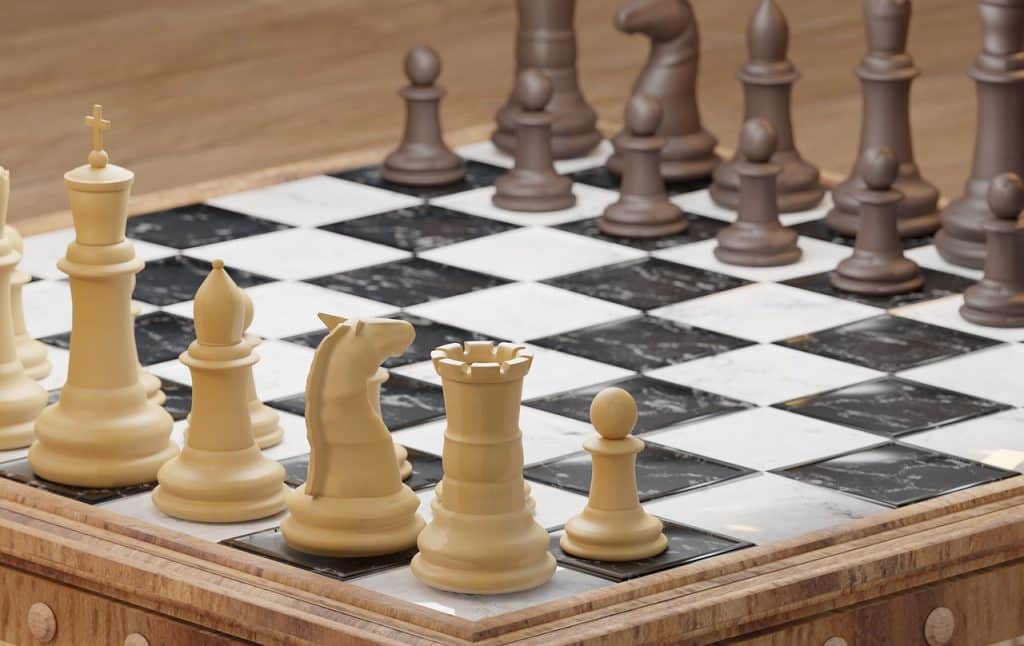Table of Contents
The Benko Gambit
The Benko gambit is one of the best options to win quick initiative with black. It’s an opening that makes you feel you are playing with the white pieces instead of black. You gain a quick attack over white’s queenside in exchange for one pawn, and you get to develop your pieces harmoniously.
Playing the Benko gambit is always refreshing, one of the best things you can do with black undoubtedly. The best part is that playing the Benko gambit is really easy, the opening is linear and has many ideas.
You will always have a plan to play, but black should indeed be prepared for some dangerous lines whites can choose. You will feel that you are making white defend, and if you like to play for the initiative this opening is for you.
Many important grandmasters used this opening so many times, like Garry Kasparov, Magnus Carlsen, Sam Shankland, and more. If you want to learn the secrets of the Benko gambit and play it like a champion keep reading this post!
The main lines of the Benko Gambit
Now, to reach the main position of the Benko gambit we will follow the next moves:
1.d4 c5 2.d5 Nf6 3.c4 b5 and here is where the good stuff starts. We can also reach the same position in different orders:
1.d4 Nf6 2.c4 c5 3.d5 b5 but this would be the same. In this position white has many options, the mainline is capturing.
First important variation: 4. Cxb5
4.cxb5 a6 Here is the gambit, we offer a pawn, but in exchange, we will have two open files, the bishop developed, and a good knight incoming.
1.d4 Nf6 2.c4 c5 3.d5 b5 4.cxb5 a6 5.bxa6 g6 6.Nc3 Bxa6 7.Nf3 Bg7 8.e4 Bxf1 9.Kxf1 d6 10.g3 O-O 11.Kg2 Nbd7. With a great position for black, rooks are going to come to b8 and a8 with strong pressure. A. Korobov, J. Xiong
Second important variation: 4. Nf3
4.Nf3 We could call this the declined Benko gambit variation, white simply ignores our pawn because he knows the dangers of it. However, this allows us to destroy the white center early on:
4… e6 Undermining white’s center, then, the line that follows will take us to advantage unavoidably:
1.d4 Nf6 2.c4 e6 3.Nf3 c5 4.d5 b5 5.Bg5 exd5 6.cxd5 d6 7.e4 a6 8.a4 Be7 9.axb5 Nxe4 10.Bxe7 Qxe7 11.Be2 O-O 12.O-O. Leaving us with a position that is hell for White, we can put pressure on the b-file, e-file, a-file, we’ll play Bb7, etc.
Third important variation: 4. a4
1.d4 c5 2.d5 Nf6 3.c4 b5 4.a4 You should definitely not worry about this variation at all, this is not recommendable. Playing like this allows black to push the pawn 4… b4, which gives a lot of space, practically white gives up the initiative.
1.d4 c5 2.d5 Nf6 3.c4 b5 4.a4 b4 5.Nd2 e5 6.e4 d6 7.b3 g6 8.Bb2 Bg7 9.Ngf3 O-O 10.g3 It’s the regular variation, which actually gives a good position for black, and chances.
However, I know the ones that play the Benko gambit are looking for blood, if you still want to sacrifice pawns we have an idea. This was a game played by the grandmaster De Wagner, in which he plays brilliantly with the black pieces:
1.d4 Nf6 2.c4 c5 3.d5 b5 4.a4 b4 5.Nd2 d6 6.e4 g6 7.Bd3 Bg7 8.f4 e5 9.fxe5 and here comes the surprise:
Ng4 10.e6 Ne5! 11.exf7+ Kxf7 12.Ndf3 Nxd3+ 13.Qxd3 Re8 PEACE WAS NEVER AN OPTION!
14.Ne2 Kg8 15.O-O Nd7 16.Bf4 Bxb2 17.Rab1 Ne5 18.Qb3 Nxf3+ 19.Qxf3 Be5 20.Bxe5 Rxe5 21.Qf7+ Kh8 22.Ng3 Ba6 23.Rf4 Qe7 24.Qxe7 Rxe7 25.Rf6 Rd8 26.Rc1 b3 27.Rf3 Rb8 28.Rfc3 Rb4 29.Nf1 b2 30.Rb1 Bxc4 31.Nd2 Ba2 0-1
The Benko Gambit for white
In the case of white, this variation is a little confusing, if you are white you have two options to face the Benko gambit:
- You can simply take and try to endure black’s pressure, you must exchange the g7 bishop. Also, you should try, by all means, to stop black’s initiative on the queenside before making any plans, if you want to play safe. If you think you have good chances of counterattacking do it, depends on the kind of position you want.
- You can refuse the gambit and strive to get a quiet position after this is what black doesn’t want. But you will have to give certain advantages to blacks early in the game.
The Benko Gambit for Black
For black is easy, but again, depends on what white chooses to play:
- If white accepts the gambit, which is 90% of the games, your job is to put pressure on the open files. The main target here is the b2 pawn, if white advances it, push c4 and breakthrough.
- If white doesn’t accept the gambit, you can find a way to seize your space advantage on the queenside. Undermine the center and develop your pieces there is also good, white will be in trouble.
Plans and ideas of the Benko Gambit
There are important ideas in this opening, we are going to list the most important factors for both sides:
- The g7 bishop is a strong piece, white will always try to exchange it at all costs, and for good reason.
- The b-file and a-file are super important for black, try to put pressure, white will try to defend it.
- Usually black can push c4, even if is another sacrifice, to post a strong knight on c5.
The important thing to remember as black is that you are playing a gambit, so you need to be aggressive. Follow the general rules of the active play, try to win tempos, delay white’s development, and so on.
As a white, you have two options: defend the attack and counterattack or counterattack directly.
You may also like:
In Chess Can a King Kill a King?






